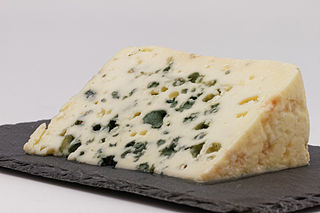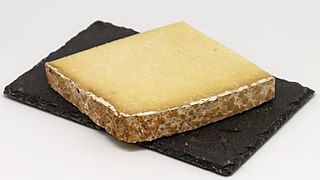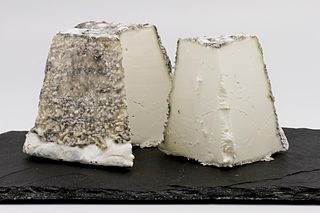
Chevrotin is a soft goat milk based cheese produced in the historical region of Savoy, (France). Since 2002 it has had an AOC designation. [1]

Chevrotin is a soft goat milk based cheese produced in the historical region of Savoy, (France). Since 2002 it has had an AOC designation. [1]
Chevrotin has been produced since the 17th century in the Alpine foothills of the Savoyard Chablais, Bauges and Aravis districts. The landscape presents difficulties to agriculture, with steep gradients, a damp climate and a thin limestone-based soil that supports a restricted vegetation. The only domesticated animals that can feed here are goats that are able to move around with the same sure-footedness as the chamois who live nearer the mountain peaks. Chevrotin is made from filtered but unpasteurised goat milk. In order to produce cheese meeting the AOC criteria, the milk must be produced by a herd of 80% alpine breed goats. [2]
The cheese is a fresh cheese with only a brief maturation period. Production tends to be a small-scale artisanal process. At a minimum, it needs three weeks to ripen. This takes place on pine timber shelves, and during ripening time each cheese is turned and washed with brine three times per week. [2] Chevrotin received the Appellation d'Origine Contrôlée (AOC) and protected designation of origin (AOP) in 2002.
The cheese takes the form of a flattened cylinder, with a diameter of 9 – 12 cm and a thickness of 3 – 4½ cm. It generally weighs 250 - 350 g. Chevrotin features a thin coating of soft reddish-brown, not unlike the rind of such better known cheeses as Munster. Chevrotin appears similar to Reblochon which is made in the same regions of Savoy, applying similar processes, but which is produced lower down the valleys using cow's milk.

Gruyère is a hard Swiss cheese that originated in the cantons of Fribourg, Vaud, Neuchâtel, Jura, and Berne in Switzerland. It is named after the town of Gruyères in Fribourg. In 2001, Gruyère gained the appellation d'origine contrôlée (AOC), which became the appellation d'origine protégée (AOP) as of 2013.

Brie is a soft cow's-milk cheese named after Brie, the French region from which it originated. It is pale in colour with a slight greyish tinge under a rind of white mould. The rind is typically eaten, with its flavour depending largely upon the ingredients used and its manufacturing environment. It is similar to Camembert, which is native to a different region of France. Brie typically contains between 60% and 75% butterfat, slightly higher than Camembert.

Roquefort is a sheep milk blue cheese from southern France. Though similar cheeses are produced elsewhere, EU law dictates that only those cheeses aged in the natural Combalou caves of Roquefort-sur-Soulzon may bear the name Roquefort, as it is a recognised geographical indication, and has a protected designation of origin.

Goat cheese, goat's cheese or chèvre is cheese made from goat's milk. Goats were among the first animals to be domesticated for producing food. Goat cheese is made around the world with a variety of recipes, giving many different styles of cheeses, from fresh and soft to aged and hard.

Camembert is a moist, soft, creamy, surface-ripened cow's milk cheese. It was first made in the late 18th century in Camembert, Normandy, in northwest France. It is sometimes compared in look, taste and texture to brie cheese, albeit with a slightly lower butterfat content than brie's typical 20% – 25% by weight.

Reblochon is a soft washed-rind and smear-ripened French cheese made in the Alpine region of Haute-Savoie from raw cow's milk. It has its own AOC designation.

Brie de Meaux is a French brie cheese of the Brie region and a designated AOC product since 1980. Its name comes from the town of Meaux in the Brie region. As of 2003, 6,774 tonnes were produced annually.

In France, the appellation d'origine contrôlée is a label that identifies an agricultural product whose stages of production and processing are carried out in a defined geographical area – the terroir – and using recognized and traditional know-how. The specificity of an AOC product is determined by the combination of a physical and biological environment with established production techniques transmitted within a human community. Together, these give the product its distinctive qualities.

Cantal cheese is an uncooked firm cheese produced in the Auvergne region of central France: more particularly in the département of Cantal as well as in certain adjoining districts. Cantal cheese was granted Appellation d'Origine Contrôlée certification in 1956. One of the oldest cheeses in France, Cantal dates back to the times of the Gauls. It came to prominence when Marshal Henri de La Ferté-Senneterre served it at the table of Louis XIV of France. Senneterre is also responsible for the introduction of Saint-Nectaire and Salers.

Banon is a French cheese made in the region around the town of Banon in Provence, south-east France.

Pont-l'Évêque is a French cheese, originally manufactured in the area around the commune of Pont-l'Évêque, between Deauville and Lisieux in the Calvados département of Normandy. It is probably the oldest Norman cheese still in production.

Grana Padano is a cheese originating in the Po Valley, in northern Italy, similar to Parmesan. There are less strict regulations governing its production compared to Parmesan. This hard, crumbly-textured cheese is made with unpasteurized cows' milk that is semi-skimmed through a natural creaming process. To preserve the authenticity of the manufacturing processes and raw materials used to make this cheese, Grana Padano is registered as Geographical Indication in Italy since 1954 and as a European Union protected designation of origin (PDO) since 1996, and is protected in several other countries based on the Lisbon Agreement and bilateral agreements.

Saint-Nectaire is a French cheese made in the Auvergne region of central France.

Époisses, also known as Époisses de Bourgogne, is a legally demarcated cheese made in the village of Époisses and its environs, in the département of Côte-d'Or, about halfway between Dijon and Auxerre, in the former duchy of Burgundy, France, from agricultural processes and resources traditionally found in that region.

Rocamadour is a French cheese from the southwest part of the country. It is produced in the regions of Périgord and Quercy and takes its name from the village of Rocamadour in the département of the Lot.

Chabichou is a traditional semi-soft, unpasteurized, natural-rind French goat cheese with a firm and creamy texture. Chabichou is formed in a cylindrical shape which is called a "bonde", per the shape of the bunghole of a wine barrel. and is aged for 10 to 20 days. It is the only goat cheese that is soft ripened allowed by Protected Designation of Origin regulations to be produced using pasteurized milk. Chabichou is very white and smooth, and flexible to the palate, with a fine caprine odor.

There are many different types of cheese. Cheeses can be grouped or classified according to criteria such as length of fermentation, texture, methods of production, fat content, animal milk, and country or region of origin. The method most commonly and traditionally used is based on moisture content, which is then further narrowed down by fat content and curing or ripening methods. The criteria may either be used singly or in combination, with no single method being universally used.

Pélardon, formerly called paraldon, pélardou and also péraudou, is a French cheese from the Cévennes range of the Languedoc-Roussillon region. It is a traditional cheese made from goat's milk. It is round soft-ripened cheese covered in a white mold weighing approximately 60 grams, with a diameter of 60–70 mm and a height of 22–27 mm. Pélardon has benefited from Appellation d'origine contrôlée (AOC) status since August 2000.